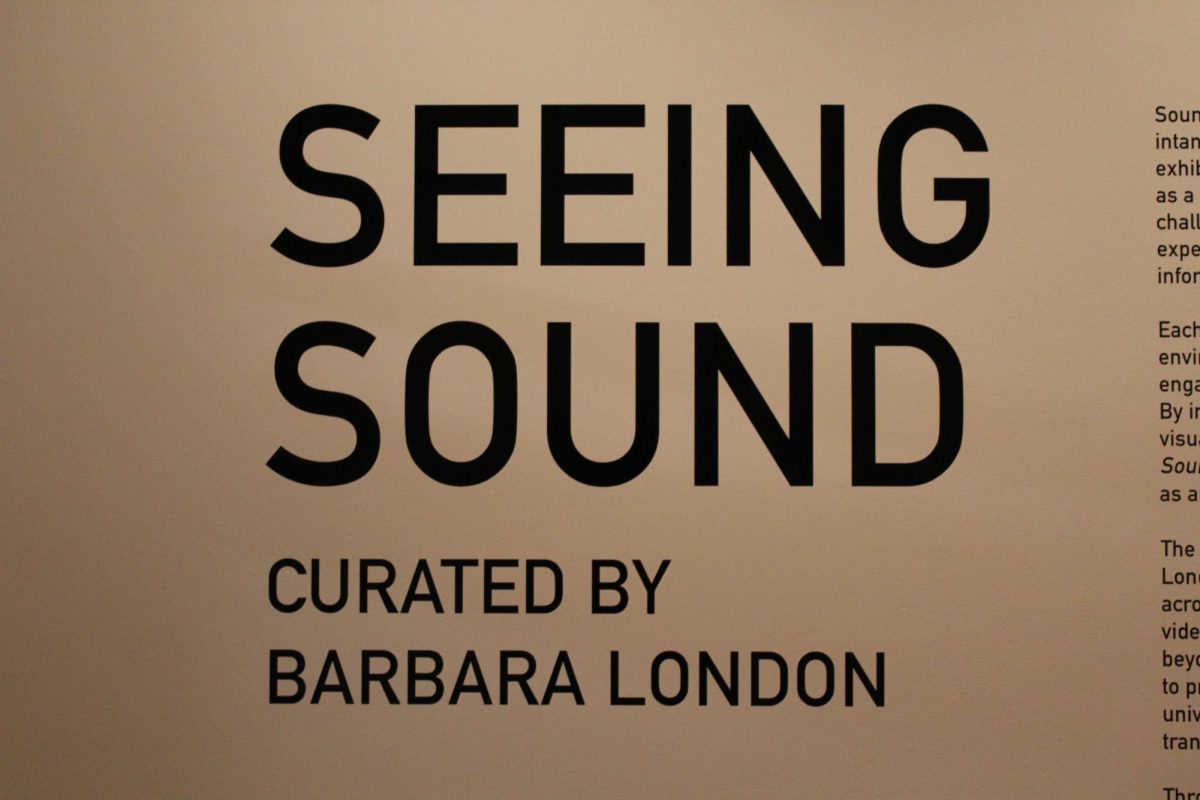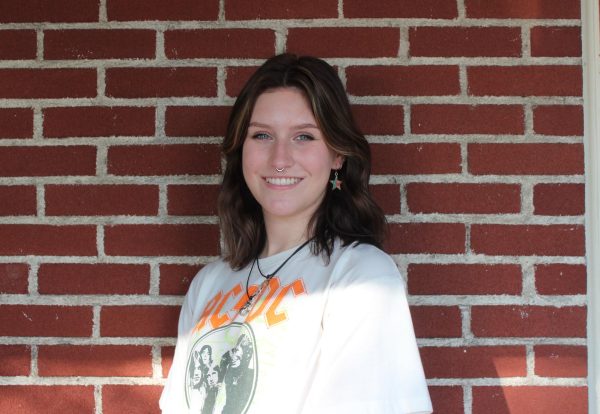The current Samek exhibit in the ELC, “Seeing Sound”, is a traveling exhibit curated by Barbara London, which showcases seven artists based in a range of locations: New York, London, Bogota, Tokyo, Singapore and Hong Kong. The preface at the entrance explains that the exhibit aims to engage with the modernized art form of sound— especially as sound has become an increasingly private experience due the progression of headphones and other auditory technology.
As someone with a soft spot for interactive and experiential art, I was excited to engage with this exhibit. I first encountered Samson Young’s (Hong Kong) piece entitled “Muted Situations #2: Muted Lion Dance”, in which a video of a costumed traditional Chinese performance of Lion Dance was projected on the wall. Young’s intention was to subvert viewers expectations by showcasing this exhibit without sound, as its usual accompaniment is booming percussion. While the music is seemingly essential to this performance, Young proved to me that it doesn’t have to be. The performers move the costumes in a way that brings them to life, making the performance just as entrancing as it would be with audio, even if the silence was initially disorienting.
It was Juan Cortes’s (Bogota) piece from his “Land” series that enraptured me the most. Atop a small black box sat a petri dish of a red metallic substance, overshadowed by a magnifying glass. I watched in amazement as the powder shifted slightly in the dish, strands of it reaching outward and upward like an urchin. I knew that the powers of sound and magnets were at work, but its movement amazed me, seeming as though it were alive—similar to the Lion Dance. The intense ringing reverberating out of the box’s speaker seemed to be the loudest sound present in the exhibit, at times increasing in volume and engulfing the space.
Yuko Mohri’s (Japan) piece “Decomposition” was another one of my favorites. On the ground sat a bowl of fruit, with two speakers outstretched in front. The electrodes inserted into the fruits measure the internal moisture level, which is projected as an actively-occurring sound while the fruit slowly decays. I crouched down to each speaker and listened: a repetitive wave of sounds that sounded as one might expect moisture to, as though it were pool water stuck in your ear. I appreciated how this piece experiments with the common recurrence of fruit in art, tactile sensations in the form of audio and the display of decomposition as a form of “memento mori.”
Aura Satz’s (Spain) piece “Dial Tone Drone” is displayed as a vintage, red telephone handset mounted on one of the Samek’s columns, just above a red chair to its right. Onlookers are invited to sit and listen in on a 14 minute recording of a commissioned conversation between “sound pioneers” Pauline Oliveros and Laurie Spiegel on the topic of drone sounds. The audio’s conversational element is overlaid on compositions by both individuals. While I did not get the chance to listen to the entire audio, I am nonetheless compelled by the idea of an audio on the topic of sound, creating an inception-like art piece.
Seth Cluett’s (United States) piece “the stratified character of nature” featured “8 vertically-mounted horn loudspeakers on stands, each holding a single UV printed photo,” and “2 small cube speakers mounted on short stands.” The audio and visuals are sourced from the bike path between the Westside Highway and then Hudson River in Riverside Park at 125th Street in New York City. As I moved throughout the speakers, I crouched slightly to better hear the audio. I heard sounds of gravel, grass, water, etc. as their individual selves, rather than hearing them all at once like physically being on the bike path would allow. At the volume these speakers were set, it was not possible to hear them all at once (in this environment, at least), creating an interesting experience that divided the elements of a soundscape.
The remaining two pieces are ones that didn’t particularly stick with me, but I don’t necessarily fault the piece or artist. Auriea Harvey’s (United States) piece “Sketchbook Movies” featured a screen playing a recording of her flipping through her past notebooks, spanning from 1990 to 2012. While visually interesting, I personally wasn’t able to hear the sound that was intended to be included, entirely offsetting the focus of the exhibit— though it is difficult to pinpoint who is at fault for this. bani haykal’s (Singapore) piece “sifrmu version 23” consisted of a keyboard on a podium, set in from flatscreen with small speakers mounted on either side. haykal experiments with language and audio in this piece through calculated encryption displayed on the screen. Visitors would watch what they had typed be encrypted into “three-character Jawi ciphertext,” accompanied by pronunciation emitted from the speakers. As I said, I don’t fault the artist for my experience of this work. The intricacies of language and coding were just difficult for me to understand, and I think I would have to sit with this piece for a while to truly comprehend it.
My overall experience with “Seeing Sounds” brought me to ask, what is the best way to display an exhibit centered around sound? Personally, I feel that my experience would have been enhanced if I had been able to experience each piece in isolation. As I had mentioned, Cortes’s piece often reached intense volumes; did its proximity to Harvey’s piece drown out the sound I was expecting to hear? Did its proximity to Young’s piece alter what was meant to be silent? Despite being further from Mohri’s and Cluett’s pieces, was Cortes’s piece’s booming sound why I had to get closer to the speakers? All of this aside, are pieces utilizing sound ever able to truly be controlled if visitor’s actions cannot be controlled? I’d be interested to see how this exhibit was displayed in different locations, so that I could gauge who or what had truly altered my experience— the curator, or the location.






















